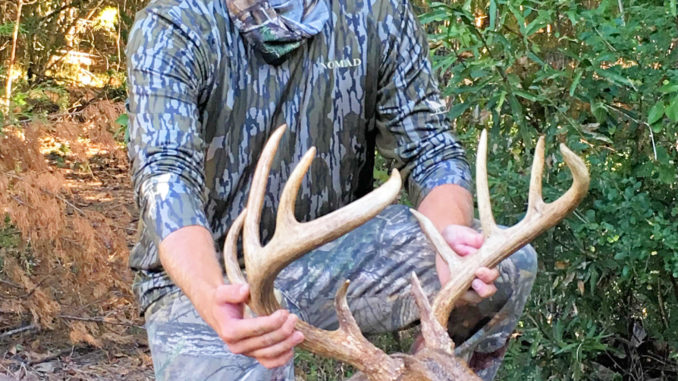
The peak of whitetails’ breeding in the Carolinas varies greatly by location; don’t count on the rut to put a buck in your sights.
Deer hunters, including those in the Carolinas, understand that the peak of the mating season, aka rut, rut can be an important factor in putting venison on the table or impressive antlers on the wall.
But marking calendars to sit in trees or ground blinds and partake in the perceived peak of the rut isn’t always a formula for success. Knowing where to position stands to take advantage of bucks using certain food sources — and when to move them — are more important, along with shadowing does.
Common knowledge says the peak of the rut — three to five days each fall — is when normally super-wary “boss of the woods” bucks pursue female whitetails with reckless abandon. Others think the peak signals the best chance to get any antlered deer within archery or firearms range.
But it is actually two to three weeks before the peak, the pre-rut, when hunters should be in the woods. That’s when bucks chase receptive does around the clock, and it always precedes the much-ballyhooed peak.
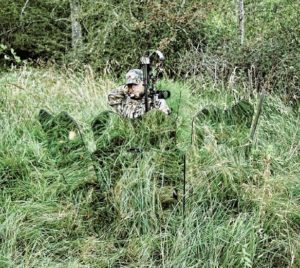
Does’ birthdates — not buck biology — actually frames the rut. The majority of doe fawns are born in May and June, which determines first estrous cycles 18 months later. with most deer in the Carolinas born in late spring, November should be the marked month for bucks chasing mature does, but it can happen much earlier or later.
Because whitetails’ gestation period is 61/2 months, deer born in March were conceived the previous September, and the fact that it sometimes happens along that time line can skew hunters’ concepts of when the rut actually kicks in.
For instance, Mack Martin, 22, of Clinton, S.C., killed a 10-point, 6½-year-old ,215-pound wall-hanger in Laurens County last Oct. 1, but he was stunned to have seen bucks chasing does two weeks earlier.
“In September bow season, I saw bucks running does,” he said. “It’s hard to tell when the rut happens.”
Martin crawled to an open oak forest that day and sat against a thick-trunk tree.
“The wind was right, so I sneaked in through some pines before daylight and sat down against an oak. I could see 200 yards,” said Martin, who was hunting with a muzzleloader. “My dad, who has several deer in the (South Carolina) record book, always hunts from the ground. I use tree stands only if I have to now.”
Just 70 miles to Martin’s northwest in Cleveland County, N.C., Eddie Callahan, 49, was hunting in early September when dropped the biggest buck taken in North Carolina last season with a crossbow, a 10-pointer who scored 1572/8 gross and 153 net inches. Hunting in early September, he hid in a blind he set up in five minutes near one end of a shooting lane in the woods off a gas line that was planted in crops. His trail-camera had captured images of the buck walking the gas line “like clockwork” for three years.
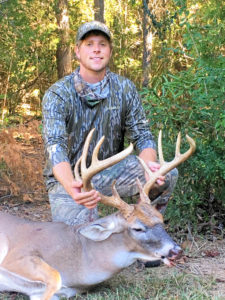
After nailing the 220-pounder behind its right shoulder, “the buck spun around two or three times and tried to stand,” Callahan said.
By then the hunter had reloaded a bolt. He aimed again, fired and heard a loud pop.
“He went straight down and never kicked,” he said. “But I couldn’t find any signs of the second arrow. When I grabbed his antlers to drag him, I cut my hand on the second broadhead sticking in his right main beam (above the G1 tine). The (bolt) must have shattered when the broadhead hit his antler, knocked him out, and he bled out before while I walked to him.”
Randy Potts of Stanly County, N.C., a 34-year-old forklift driver for Culp Lumber, identified food sources to locate a tree stand site “between a food plot, 80 yards from another hunter’s corn pile and 20 yards from my own automatic feeder that put out (persimmon-scented) corn.”
He wound up popping a pre-rut September swamp donkey, a 147-inch Anson County Pope & Young 8-pointer that weighed 215 pounds.
Doe-watching early in the 2017 season gave Adrian Whitson of Burnsville, N.C., a better idea for stand placement in Yancey County for a hunt on Thanksgiving Day, which is several weeks before the peak of the rut in North Carolina’s western mountains.
“I kept seeing bucks and does 200 yards above my stand,” said Whitson, 37. “So I moved an old Summit tree stand nearer the top of a 4,000-foot elevation mountain.”
He left corn on the ground near his old bow perch 60 yards below his new spot, but he sprayed Tink’s 69 deer scent into the air. The area’s dominant buck apparently detected the aroma and walked straight to Whitson, who dropped it with a single shot from a .Ruger 223 rifle.
“It’s a kid’s gun, but I can put it in my backpack so it’s easy to carry in the mountains,” Whitson said.
The buck’s almost perfect 5×5 rack taped 1716/8 gross and 1654/8 net inches and was the biggest typical buck taken by gun entered in the big-buck contest at the Dixie Deer Classic in Raleigh this past March.

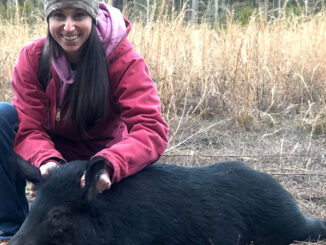
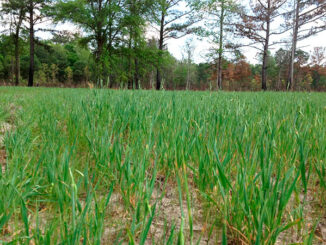
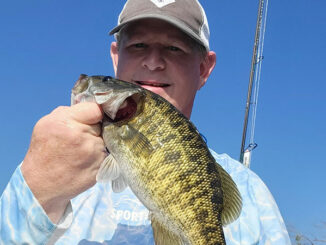

Be the first to comment